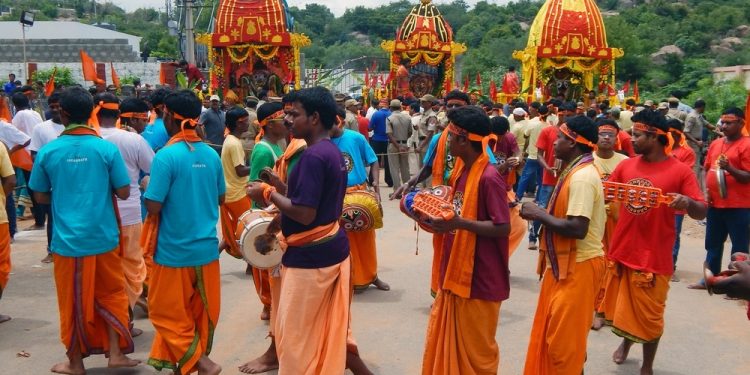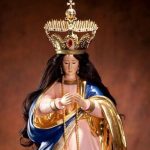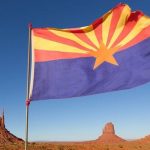
Rath Yatra
Rath Yatra is a Hindu festival that is celebrated on the Eastern coast of India. It is celebrated in Puri, the temple town of Orissa, every year on the second day of the month of Ashad. This placement on the Hindu calendar places it between June and July on the Gregorian calendar. This holiday is known as Ratha Jatra in Odia and in English is known as the Chariot Festival. It is a day that commemorates Jagannath and other Hindu deities associated with him. In the seventeenth century, Ratha Yatra inspired the English loanword “juggernaut,” a word that was originally sourced from the Hindu word “Jagannath,” which means “lord of the world.” The word became common during the 19th century and has since been used to describe something that is unstoppable.
The History Of Rath Yatra
Although the exact origin of this festival is unknown, many scholars attribute the practice of placing these three idols in giant chariots and transporting them back and forth from the temple to be a practice that was borrowed from the Buddhists. In the Buddhist tradition, idols of Buddha were often placed in a cart and paraded around town for all the world to see.
The origins of this holiday are supported by an interesting legend. A legend that begins in one of several different ways. One of them speaks of the King of Puri in the east who tried to steal Krishna’s heart. The heart had been submerged in the Dwarka Sea after his cremation and had reappeared to the tribespeople as an idol. The king named Indrayumna tried to claim it for himself, but the idol disappeared. As repentance, the king would seek absolution from Krishna by sanctifying him in another form. Another legend speaks about how Krishna’s grief-stricken siblings, his brother Balabhadra and his sister Subhadra, rushed into the Dwarka sea carrying his partially cremated body. That moment, King Indrayumna dreamed that Krishna’s body had washed ashore as a log.
The parts of these two legends that are similar are that King Indrayumna decided to build a temple to house a log and then found craftsmen to create idols from it. According to most legends, God’s architect Vishwakarma arrived to assist him, disguised as an old carpenter. The old carpenter agreed to carve the idols for him, but only on the condition that he would not be disturbed during the creation process. However, the carpenter didn’t emerge from his workshop for several weeks, not even to fetch food or water, so King Indrayumna grew impatient and threw open the door to the workshop. When he threw open the door, the idols were only half-finished, but the old carpenter had disappeared. Since the king believed that the idols were made from the very body of God, he decided to go ahead and sanctify them to be placed into the temple.
Where Krishna’s half-cremated body is believed to have been immersed into the ocean is at Dwarka in Gujarat on the western coast of India. The area where it is said that Krishna reemerged as a log is located at Puri in Orissa. Approximately 5 centuries ago, Shree Sarangdasji, a traveling Hindu saint and priest of the Hanuman temple in Gujarat, arrived in Puri to offer prayers at the Jagannath Temple. According to lore, while he was sleeping at the temple guesthouse, he received instructions from Lord Jagannath in the form of a vision to go back to Ahmedabad in Gujarat and install three idols of Jagannath, Balabhadra, and Subhadra at that location. He carried out the instructions in his dream and founded the Ahmedabad Jagannath Temple. He sanctified the two locations: the first where Krishna’s mortal remains began their journey, and their transformation as Puri’s Lord Jagannath in the east.
Approximately 145+ years ago, one of the founder’s disciples, a man named Shree Narsinhdasji Maharaj, began the Ahmedabad Rath Yatra. The deities are placed upon chariots and are pulled by humans and elephants alike. This replicates the journey to Puri and a set of rituals is done to sanctify the two places where Krishna’s mortal remains rest.
How The Rath Yatra Is Observed
During this festival, the idols of Jagannath, Balabhadra, and Subhadra are taken from the temple in Puri, loaded onto enormous chariots, and pulled by thousands of devotees and by elephants to the countryside. After a nine-day sojourn in the countryside, the idols are then returned to the city temple.
When the festival has concluded, the chariots are taken apart and their wood is then used as fuel in the kitchens of the temple. The temple’s kitchen is believed to be the biggest in the world and can be used to make enough food for up to 200,000 people. After the festival, the elephants are also returned to the temple trusts. This is where they are allowed to roam free until it’s time for the procession the next year.








